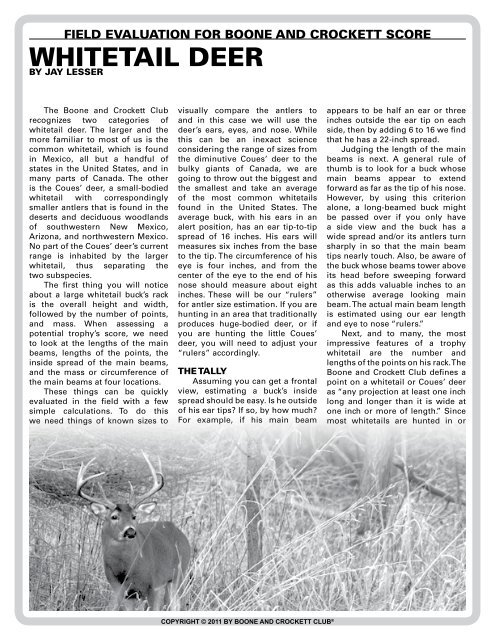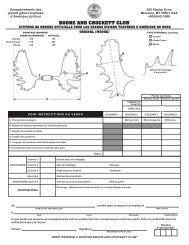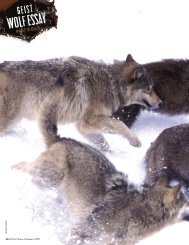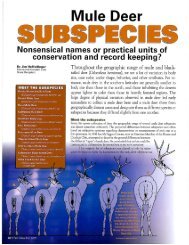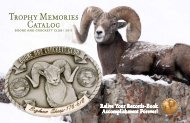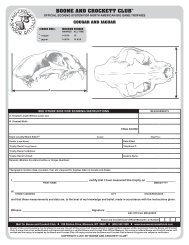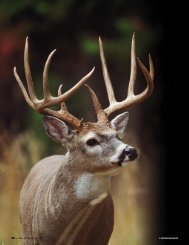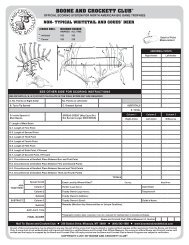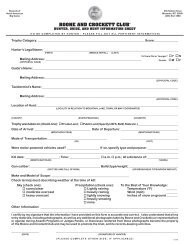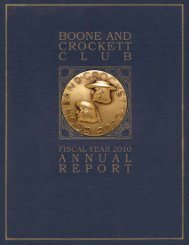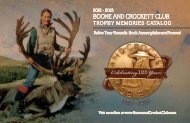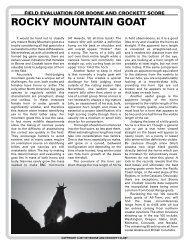WHITETAIL DEER - Boone and Crockett Club
WHITETAIL DEER - Boone and Crockett Club
WHITETAIL DEER - Boone and Crockett Club
- No tags were found...
You also want an ePaper? Increase the reach of your titles
YUMPU automatically turns print PDFs into web optimized ePapers that Google loves.
Field Evaluation for <strong>Boone</strong> <strong>and</strong> <strong>Crockett</strong> ScoreWhitetail Deerby Jay LesserThe <strong>Boone</strong> <strong>and</strong> <strong>Crockett</strong> <strong>Club</strong>recognizes two categories ofwhitetail deer. The larger <strong>and</strong> themore familiar to most of us is thecommon whitetail, which is foundin Mexico, all but a h<strong>and</strong>ful ofstates in the United States, <strong>and</strong> inmany parts of Canada. The otheris the Coues’ deer, a small-bodiedwhitetail with correspondinglysmaller antlers that is found in thedeserts <strong>and</strong> deciduous woodl<strong>and</strong>sof southwestern New Mexico,Arizona, <strong>and</strong> northwestern Mexico.No part of the Coues’ deer’s currentrange is inhabited by the largerwhitetail, thus separating thetwo subspecies.The first thing you will noticeabout a large whitetail buck’s rackis the overall height <strong>and</strong> width,followed by the number of points,<strong>and</strong> mass. When assessing apotential trophy’s score, we needto look at the lengths of the mainbeams, lengths of the points, theinside spread of the main beams,<strong>and</strong> the mass or circumference ofthe main beams at four locations.These things can be quicklyevaluated in the field with a fewsimple calculations. To do thiswe need things of known sizes tovisually compare the antlers to<strong>and</strong> in this case we will use thedeer’s ears, eyes, <strong>and</strong> nose. Whilethis can be an inexact scienceconsidering the range of sizes fromthe diminutive Coues’ deer to thebulky giants of Canada, we aregoing to throw out the biggest <strong>and</strong>the smallest <strong>and</strong> take an averageof the most common whitetailsfound in the United States. Theaverage buck, with his ears in analert position, has an ear tip-to-tipspread of 16 inches. His ears willmeasures six inches from the baseto the tip. The circumference of hiseye is four inches, <strong>and</strong> from thecenter of the eye to the end of hisnose should measure about eightinches. These will be our “rulers”for antler size estimation. If you arehunting in an area that traditionallyproduces huge-bodied deer, or ifyou are hunting the little Coues’deer, you will need to adjust your“rulers” accordingly.The TallyAssuming you can get a frontalview, estimating a buck’s insidespread should be easy. Is he outsideof his ear tips? If so, by how much?For example, if his main beamappears to be half an ear or threeinches outside the ear tip on eachside, then by adding 6 to 16 we findthat he has a 22-inch spread.Judging the length of the mainbeams is next. A general rule ofthumb is to look for a buck whosemain beams appear to extendforward as far as the tip of his nose.However, by using this criterionalone, a long-beamed buck mightbe passed over if you only havea side view <strong>and</strong> the buck has awide spread <strong>and</strong>/or its antlers turnsharply in so that the main beamtips nearly touch. Also, be aware ofthe buck whose beams tower aboveits head before sweeping forwardas this adds valuable inches to anotherwise average looking mainbeam. The actual main beam lengthis estimated using our ear length<strong>and</strong> eye to nose “rulers.”Next, <strong>and</strong> to many, the mostimpressive features of a trophywhitetail are the number <strong>and</strong>lengths of the points on his rack. The<strong>Boone</strong> <strong>and</strong> <strong>Crockett</strong> <strong>Club</strong> defines apoint on a whitetail or Coues’ deeras “any projection at least one inchlong <strong>and</strong> longer than it is wide atone inch or more of length.” Sincemost whitetails are hunted in orCopyright © 2011 by <strong>Boone</strong> <strong>and</strong> <strong>Crockett</strong> <strong>Club</strong> ®
near heavy cover where there mayonly be seconds to assess theirantlers, we need a quick way tocount points.Points may be quickly countedby assuming that an overwhelmingmajority of mature whitetail bucksgrow a brow tine on each antler <strong>and</strong>that the main beam tip usually liesalmost horizontally. This allows usto count the st<strong>and</strong>ing normal pointsG-2, G-3, G-4, etc., <strong>and</strong> quickly addthat to the number 2 (brow tine <strong>and</strong>beam tip). With this method youcan quickly determine that a buckwith two st<strong>and</strong>ing normal pointsper side is a 4x4 or 8-pointer, <strong>and</strong>with three st<strong>and</strong>ing points per sidehe is a 5x5 or 10-pointer, <strong>and</strong> soon, with the exception of Coues’whitetail. Nearly all the bucks thatmake the records book have atleast five normal points per side.The length of the points can beestimated using the same “rulers”we used for the main beams.The typical pattern of a maturewhitetail’s antler developmentis an unbranched main beamthat normally develops fromthree to seven (sometimes more)unbranched points per antler atroughly spaced intervals. Any otherpoints are considered “abnormal”<strong>and</strong> their lengths are deductedfrom the score if the buck is scoredas a typical or added to the score ifit is being scored as a non-typical.Estimating the mass orcircumference measurements ofthe antler is where we use ourdeer’s four-inch eye circumferenceas the “ruler.” Compare the antler atH-1, H-2, etc., to the eye. How muchbigger is the antler? If it were halfagain bigger, the circumferencemeasurement at that point wouldbe about six inches.Ideally, the rack should beviewed from the front <strong>and</strong> theside especially when judging themain beams. However, this isn’talways possible <strong>and</strong> sometimesyou will just have to go with yourgut feeling. But beware of the rearview, as it can be deceiving. Fromthis angle you get an exaggeratedimpression of the antler’s height<strong>and</strong> spread.MAXIMUM vs. MINIMUMA Comparison of Two Records-BookWhitetail Deer – typicalWorld’s RecordTypical whitetail deerScore: 213-5/8TROPHY ANALYSIS■ Symmetrical 6x6■ Inside spread over 27 inches■ Main beams measuring over28 inches■ Above average G-1s■ Above average point lengthMinimum EntryTypicalwhitetail deerScore: 160TROPHY ANALYSIS■ Typical 5x5 frame■ Inside spread just over 21 inches■ Not lacking in anything: mass,point lengths, or long beams.This is a great 5x5 buck thathas deductions totalling over10 points. Notice the abnormalpoints on the bases <strong>and</strong> a smalldeduction for symmetry inthe G-2s.Copyright © 2011 by <strong>Boone</strong> <strong>and</strong> <strong>Crockett</strong> <strong>Club</strong> ®
The most practical way topractice your field-judging skills isto estimate the score of mountedheads. Use the buck’s “rulers” toestimate the score, then check yourcalculations by actually measuringthe rack. With a little practice,you will be surprised how closeyour estimates will become. Onelast word of advice, when thetime comes to shoot, don’t botherlooking at the antlers one moretime. It can cause your nervoussystem to do strange things.Field Judging Coues’WhitetailCoues’ deer are miniature,desert-dwelling cousins of thefamiliar whitetail. Therefore, youare looking for the same featuresas in whitetails, only reduced inexpression. Coues’ deer antlerstend to form semi-circles, with theantler tips often pointing towardeach other. Seldom will a Coues’deer show the “wide-open” lookthat is fairly common in whitetails.Often, there is very little distancebetween the antler tips, <strong>and</strong> somemay nearly touch each other. Amature Coues’ deer antler set maywell look like a small whitetailset, although usually developedto a more “finished” look overall.Interestingly, the antler beams ofCoues’ deer may well be nearly asthick as those on a mature whitetail.There will be at least threewell-developed points (plus beamtip) on each antler for a near-booktypical Coues’ deer trophy, <strong>and</strong> theinside spread will need to be near15 inches. The general look of therack will be mature, with the secondpoint on each antler being usuallythe longest of the side <strong>and</strong> the antlertips pointing toward each other.A large non-typical Coues’deer will show these qualities plusseveral noticeable abnormal points.Roughly, the abnormal pointswill need to total about 10 inches(current typical all-time recordsbook minimum entry score is 110<strong>and</strong> that for non-typical is 120),which means generally about threeor four abnormal points on the rack.MAXIMUM vs. MINIMUMA Comparison of Two Records- BookCoues’ Whitetail DeerMinimum EntryTypical Coues’ whitetail deerScore: 104-1/8TROPHY ANALYSIS■ 5x4 frame■ Only 2-6/8 inches insymmetry deduction■ Strong G-2s <strong>and</strong> G-3s –9-6/8 <strong>and</strong> 9-2/8 inches,respectively■ Good main beams – 16<strong>and</strong> 15 inches■ Lacks overall massWorld’s RecordTypical Coues’whitetail deerScore: 144-1/8TROPHY ANALYSIS■ Mass, mass, <strong>and</strong> more mass■ 5x6 frame■ Extra long main beams –20-2/8 <strong>and</strong> 20-5/8 inches■ Only 4-7/8 inches insymmetry deductionCopyright © 2011 by <strong>Boone</strong> <strong>and</strong> <strong>Crockett</strong> <strong>Club</strong> ®
Main Beam LengthSpread CreditCircumference Measurements Between PointsIndicates Circumference DivisionsAverageTypical Whitetail% OfScoreG1 - First Point LengthG2 - Second Point LengthG3 - Third Point LengthG4 - Fourth Point LengthG5- Fifth - Seventh Point(if 6th <strong>and</strong> 7th point present)Typical WhitetailH1H2H3H4H1 - Circ. at Smallest Place Between Burr <strong>and</strong> 1st PointH2 - Circ. at Smallest Place Between 1st <strong>and</strong> 2nd PointH3 - Circ. at Smallest Place Between 2nd <strong>and</strong> 3rd PointH4 - Circ. at Smallest Place Between 3rd <strong>and</strong> 4th Point25.63 Main Beam Length 30%19.75 Spread Credit 12%5.50 First Point Length 6%10.10 Second Point Length 12%10.12 Third Point Length 12%6.25 Fourth Point Length 7%0.88Fifth - Seventh Point(if 6th <strong>and</strong> 7th point present)1%4.824.32Circ. at Smallest PlaceBetween Burr <strong>and</strong> 1st PointCirc. at Smallest PlaceBetween 1st <strong>and</strong> 2nd Point6%5%4.52Circ. at Smallest PlaceBetween 2nd <strong>and</strong> 3rd Point5%4.17Circ. at Smallest PlaceBetween 3rd <strong>and</strong> 4th Point4%Average Final Score 171.49AverageTypical Coues’ Whitetail% OfScore17.72 Main Beam Length 32%Typical Coues’H1H2H3H414.22 Spread Credit 13%3.34 G1 - First Point Length 6%7.14 G2 - Second Point Length 13%5.96 G3 - Third Point Length 10%0.93 G4 - Fourth Point Length 2%0.04G5- Fifth - Seventh Point(if 6th <strong>and</strong> 7th point present)1%3.85Circ. at Smallest PlaceBetween Burr <strong>and</strong> 1st Point7%3.51Circ. at Smallest PlaceBetween 1st <strong>and</strong> 2nd Point6%3.55Circ. at Smallest PlaceBetween 2nd <strong>and</strong> 3rd Point6%2.77Circ. at Smallest PlaceBetween 3rd <strong>and</strong> 4th Point4%Average Final Score 112.46Resources Available from the <strong>Boone</strong> <strong>and</strong> <strong>Crockett</strong> <strong>Club</strong><strong>Boone</strong> <strong>and</strong> <strong>Crockett</strong> <strong>Club</strong> Field Guide to Measuring <strong>and</strong> Judging Big Game, 2nd EditionThe definitive manual for anyonewith a desire to learn the <strong>Boone</strong> <strong>and</strong><strong>Crockett</strong> <strong>Club</strong>’s world-famous big gamemeasuring system is now available inthis updated, convenient field guide thateasily fits into backpacks.Inside you will find detailed instructionson how to score each of the nativeNorth American big game categoriesrecognized by the <strong>Club</strong>, includingnumerous illustrations to clearlydemonstrate techniques for propermeasurement. Also included in this fieldguide are techniques for evaluating <strong>and</strong>field judging the most popular speciesof North American big game.Other important sections of the field guide include:n A chapter on general measuring techniques fornative North American big gamen Scoring instructions <strong>and</strong> scorecharts for all38 categories of North American big gamerecognized by the <strong>Club</strong>n Boundary descriptions for species such as elk,blacktail deer, grizzly <strong>and</strong> Alaska brown bear,whitetail, <strong>and</strong> cariboun Table of the quarter locations for easy referencewhen measuring all big game categorieswith hornsn A chapter on underst<strong>and</strong>ing the dynamics ofhunting <strong>and</strong> spotting optics.For more information or to order visitwww.boone<strong>and</strong>crockettclub.com or call 406-542-1888Copyright © 2011 by <strong>Boone</strong> <strong>and</strong> <strong>Crockett</strong> <strong>Club</strong> ®
BOONE AND CROCKETT CLUB ®OFFICIAL SCORING SYSTEM FOR NORTH AMERICAN BIG GAME TROPHIESTYPICAL <strong>WHITETAIL</strong> AND COUES’ <strong>DEER</strong>(check one):Minimum ScoresAwards All-timer whitetail 160 170r Coues’ 100 110ECBG2EG3G4G5EDEH4Detail of PointMeasurementH3H2H1EG1FEAbnormal PointsRight AntlerLeft AntlerSee other side for scoring instructionsBelow Data (A, B, & c) do not calculate in the final score but are requiredA. No. Points on Right Antler No. Points on Left AntlerB. Tip to Tip Spread C. Greatest Spread SubtotalsTOTAL TO ED. Inside Spread ofMain BeamsE. Total of Lengths of Abnormal PointsF. Length of Main BeamG-1. Length of First PointG-2. Length of Second PointG-3. Length of Third PointG-4. Length of Fourth Point, If PresentG-5. Length of Fifth Point, If PresentG-6. Length of Sixth Point, If PresentG-7. Length of Seventh Point, If PresentSpread Credit (May Equal ButNot Exceed Longer MAIN BEAM)Column 1 Column 2 Column 3Right Antler Left Antler DifferenceH-1. Circumference at Smallest Place Between Burr <strong>and</strong> First PointH-2. Circumference at Smallest Place Between First <strong>and</strong> Second PointsH-3. Circumference at Smallest Place Between Second <strong>and</strong> Third PointsH-4. Circumference at Smallest Place Between Third <strong>and</strong> Fourth PointsTOTALSAddTogether:Spread Credit Exact Locality Where Killed:* County: State/Prov:Column 1 Hunter (Legal Name): Date Killed:Column 2 Trophy Owner (Legal Name): Telephone #:SubtotalTrophy Owner’s Address:SUBTRACT: Column 3 Trophy Owner’s Email: Guide’s Name:FINAL SCORERemarks (Mention Any Abnormalities or Unique Qualities):* Geographic location (lake, mountain, river, etc.) required for trophies taken in Canada <strong>and</strong> Alaska. <strong>Boone</strong> <strong>and</strong> <strong>Crockett</strong> <strong>Club</strong>© Official Measurer I.D. NumberMail To: <strong>Boone</strong> <strong>and</strong> <strong>Crockett</strong> <strong>Club</strong> n 250 Station Drive, Missoula, MT 59801 n (406) 542-1888 n www.boone<strong>and</strong>crockettclub.comNo part of this scoring system may be altered in any way. No part of this score chart may be altered or copied without express written permission from the <strong>Boone</strong> <strong>and</strong> <strong>Crockett</strong><strong>Club</strong>. A score chart is not authenticated until signed <strong>and</strong> dated by a certified <strong>Boone</strong> <strong>and</strong> <strong>Crockett</strong> <strong>Club</strong> Official Measurer. No scores are official <strong>Boone</strong> <strong>and</strong> <strong>Crockett</strong> scores untilverified <strong>and</strong> the trophy is accepted by the <strong>Boone</strong> <strong>and</strong> <strong>Crockett</strong> <strong>Club</strong>. All trophy entries into the <strong>Boone</strong> <strong>and</strong> <strong>Crockett</strong> <strong>Club</strong>’s Awards Programs are subject to verification.Copyright © 2011 by <strong>Boone</strong> <strong>and</strong> <strong>Crockett</strong> <strong>Club</strong> ®
Protect Your Hunting HeritageJoin the <strong>Boone</strong> <strong>and</strong> <strong>Crockett</strong> <strong>Club</strong> <strong>and</strong> Help Promote Fair Chase Hunting!The single-most critical element facing the future of hunting <strong>and</strong> our wildlifeis the continued public acceptance of recreational hunting.When hunting is viewed as a fair <strong>and</strong> ethical endeavor in support ofscience-based game management programs the voting majority(non-hunters) accept hunting. Join your fellow hunterconservationistswho believe that ethical sportsmanlikebehavior is the only way to ensure a positive public imageof hunters <strong>and</strong> hunting. Become a part of 120-year-oldcommitment to preserving our hunting heritage.Mission StatementIt is the policy of the <strong>Boone</strong> <strong>and</strong> <strong>Crockett</strong> <strong>Club</strong> topromote the guardianship <strong>and</strong> provident managementof big game <strong>and</strong> associated wildlife in North America<strong>and</strong> maintain the highest st<strong>and</strong>ards of fair chase <strong>and</strong>sportsmanship in all aspects of big game hunting,in order that this resource of all the people maysurvive <strong>and</strong> prosper in its natural habitats. Consistentwith this objective, the <strong>Club</strong> supports the use <strong>and</strong>enjoyment of our wildlife heritage to the fullest extentby this <strong>and</strong> future generations.By joining today you will receive:■ Four issues of Fair Chase, the officialpublication of the <strong>Boone</strong> <strong>and</strong> <strong>Crockett</strong> <strong>Club</strong>.■ A 20% discount on <strong>Club</strong> books.■ Access to exclusive areas of the <strong>Club</strong>’sweb site.■ Wallet I.D. card <strong>and</strong> a Hunt Fair Chasewindow decal.TO sign up for a one year associate membership for $35 CALL TOLL-FREE(888) 840-4868 OR JOIN ONLINE ATwww.<strong>Boone</strong><strong>and</strong><strong>Crockett</strong><strong>Club</strong>.com<strong>Boone</strong> <strong>and</strong> <strong>Crockett</strong> <strong>Club</strong> ® INSTRUCTIONS FOR MEASURING TYPICAL <strong>WHITETAIL</strong> AND COUES’ <strong>DEER</strong>All measurements must be made with a 1/4‐inch wide flexible steel tape to the nearest one‐eighth of an inch. (Note: A flexible steel cable can beused to measure points <strong>and</strong> main beams only.) Enter fractional figures in eighths, without reduction. Official measurements cannot be taken untilthe antlers have air dried at a habitable room temperature for at least 60 days after the animal was killed. The 60-day drying period for a trophy thathas been frozen or boiled begins the day it is removed from the freezer, boiling pot, or submersion in any liquid.A. Number of Points on Each Antler: To be counted a point, the projection must be at least one inch long, with the length exceeding width atone inch or more of length. All points are measured from tip of point to nearest edge of beam as illustrated. Beam tip is counted as a pointbut not measured as a point. Point totals do not add into the final score.B. Tip to Tip Spread is measured between tips of main beams. Tip to tip spread does not add into the final score.C. Greatest Spread is measured between perpendiculars at a right angle to the center line of the skull at widest part, whether across mainbeams or points. Greatest spread does not add into the final score.D. Inside Spread of Main Beams is measured at a right angle to the center line of the skull at widest point between main beams. Enter thismeasurement again as the Spread Credit if it is less than or equal to the length of the longer main beam; if greater, enter longer main beamlength for Spread Credit.E. Total of Lengths of all Abnormal Points: Abnormal Points are those non‐typical in location (such as points originating from a point orfrom bottom or sides of main beam) or extra points beyond the normal pattern of points. Measure in usual manner <strong>and</strong> enter in appropriateblanks.F. Length of Main Beam is measured from the center of the lowest outside edge of burr over the outer side to the most distant point of themain beam. The point of beginning is that point on the burr where the center line along the outer side of the beam intersects the burr, thenfollowing generally the line of the illustration.G‐1‐2‐3‐4‐5‐6‐7. Length of Normal Points: Normal points project from the top of the main beam. They are measured from nearest edge ofmain beam over outer curve to tip. Lay the tape along the outer curve of the beam so that the top edge of the tape coincides with the top edgeof the beam on both sides of the point to determine the baseline for point measurements. Record point lengths in appropriate blanks.H‐1‐2‐3‐4. Circumferences are taken as detailed in illustration for each measurement. If brow point is missing, take H‐1 <strong>and</strong> H‐2 at smallestplace between burr <strong>and</strong> G‐2. If G‐4 is missing, take H‐4 halfway between G‐3 <strong>and</strong> tip of main beam.


